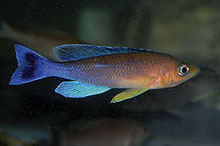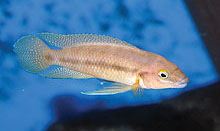WHAT'S NEW ACROSS THE WORLD
Select date in side bar to go to a What's New of previous issues
| What's New
©by Laif DeMason
Snow has already fallen over many of the northern states now and the winter season is upon us. Who knows what kind of weather this winter will bring—subzero freezes or severe blizzards with towering snow drifts? In any event, fish keepers will likely now pay more attention to their fish and fish tanks. Time to check out what friends are keeping and go to a few fun fish club events. Here at Cichlid News, we wish you all a happy and prosperous New Year!
Here’s “what’s new” on the cichlid scene: |
Lake Malawi
While captive bred Malawi cichlids of all sizes are generally found in most large fish stores; wild fishes are less often found in any store due to the large price commanded compared to the bred forms. Still there are some hot wild species that collectors seek like predatory haplochromines and other particular groups, which all depends if you are in China, Europe, or the USA.

One of the most popular cichlids whether wild or tank raised is the Lichnochromis acuticeps or the so-called “Malawi Gar”. Wild caught specimens are incidental at best and rarely have any color at all. Photo by A. Konings.
|

Professional fish breeders bred many of the wild types of Labeotropheus fulleborni years ago. Now however, many bred varieties offered cannot be actually traced back to any one wild form or location, due to the rigorous selection for OB types. Pictured here is a Lab. fuelleborni sold as “OB orange”.
|

For American hobbyists, the several Copadichromis spp. named “Mloto” are currently in demand. Of late, the Copadichromis from Kirondo, Tanzania have been exported as “Mloto Multicolor” because of its white blaze, but is really a kawanga borleyi or verduyni species. Photo by A. Konings.
|

Malawi cichlid products from the Far East continue to evolve along the with the desired traits hobbyists there prize. Pictured here is man-made Aulonocara variety where big candy apple red egg spots are found throughout the body and fins of a dragon blood peacock strain. Likely these fish are randomly produced and pick out of many spawns, not unlike koi, selected by the desired colors without any true breeding parents.
|
Lake Tanganyika
The popularity of Tanganyikan cichlids has also spilled into fish shops with shopkeepers ordering more and more of these fishes. Both Zambia and Tanzania continue to regularly export, picking up the slack that the closing of Burundi exports enabled. Regular ventures into Southern Congo also continue with the frequent collections of “Zaire Blue” frontosa. Sales of these frontosas have been up and down unpredictably of late.
| WHAT'S NEW: LAKE TANGANYIKA |

Zambian exporters rely heavily on southern Congo species to boost their variety to export. Several red forms of Tropheus moorii were sampled lately. Pictured here T. moorii from Livua; note the very rich red markings around the throat area.
|

Another new red form of T. moorii was collected from Kalindi, Congo. This form is touted as a super red colored type thus adding it to the cache of extremely red forms found from Ndole, Zambia through the southern Congo locations.
|

Also from Kalindi, Congo, a new black Altolamprologus compressiceps variety similar to the so-called “zebra calvus” types due to the white spangles present in adults, reminding us of A. calvus, and the strong zebra barring of their fry.
|

A nice surprise was imported of late, the so-called “blue orchid” type of the Cyprichromis sp. jumbo leptosoma hailing from Livua, Congo. While some males have blue-white fin markings, many male in this and all populations around the lake actually have black or yellow fins as well.
|

Various Petrochromis species from different areas have been sampled over the last few years to see what stimulates the specialists who keep these ‘rough-house’ fish. Recently P. famula from Kasanga, Tanzania were imported; pictured here. Photo by A. Konings.
|

Only rarely collected and exported from various points on the lake, Neolamprologus bifasciatus are very hard to find as wild fish. Fortunately there are some who not only succeeded in finding a few to purchase, but also breed them as well; offering fry.
|
Select date in side bar to go a What's New of previous issues |









